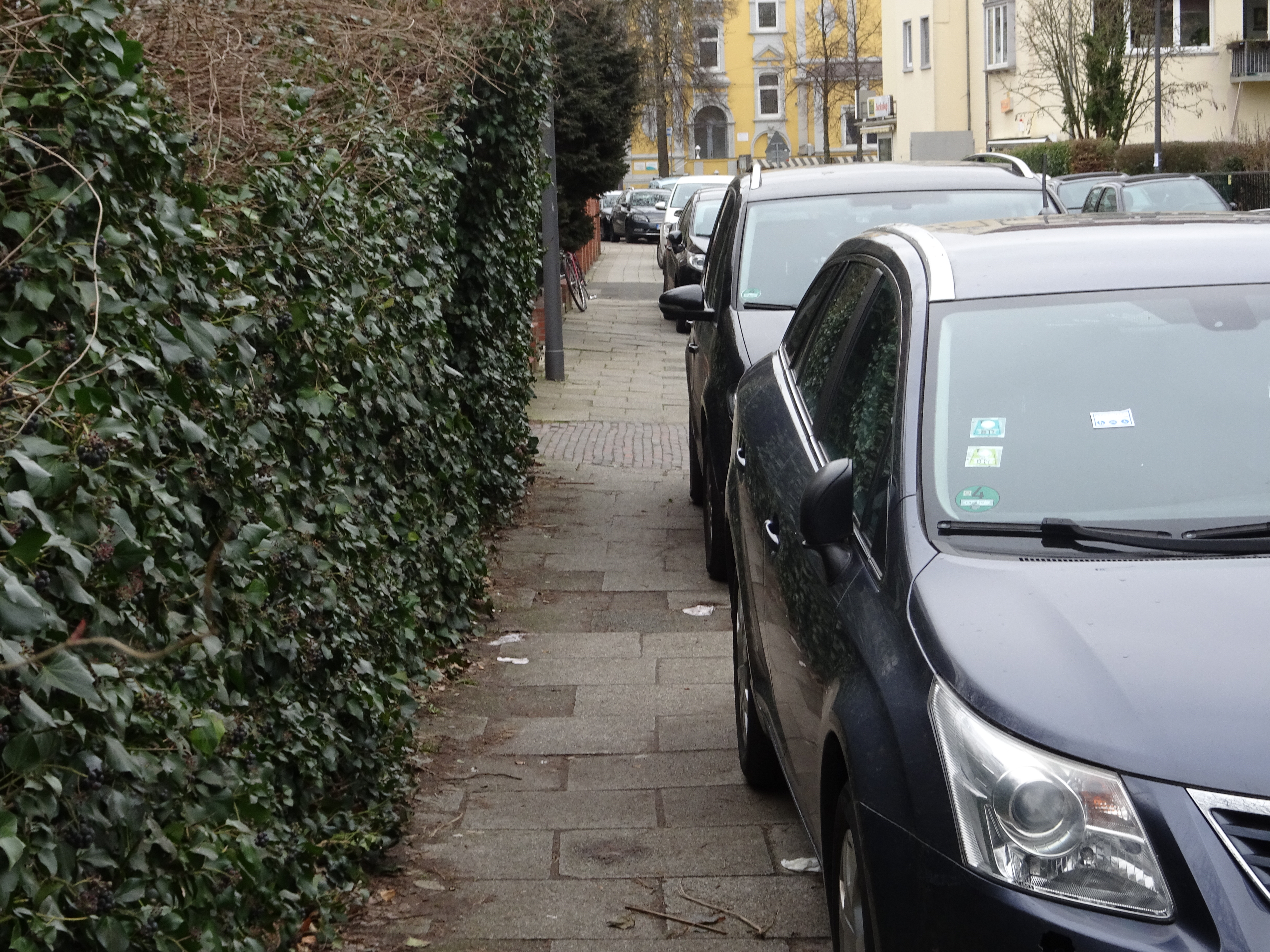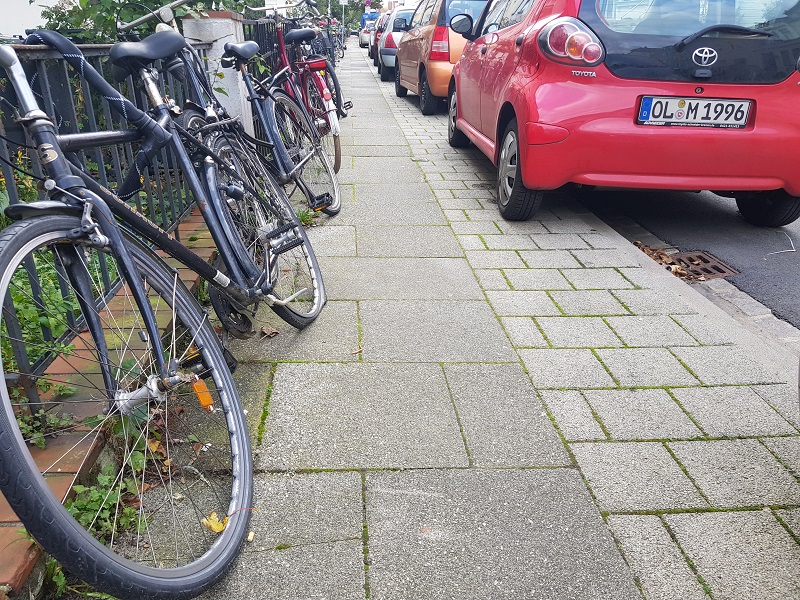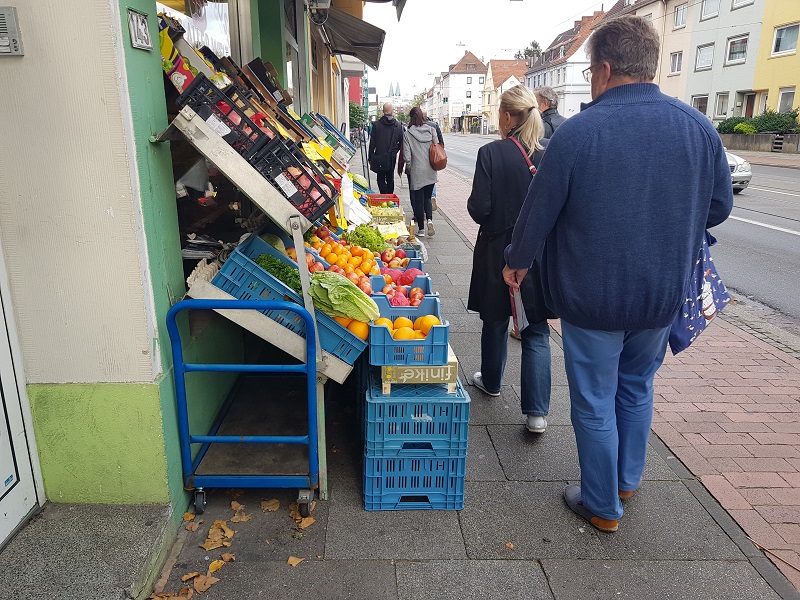At present, the share of foot traffic in Bremen is at its lowest level (21%), less is not possible. And this is because the conditions for foot traffic in Bremen are very poor.

This is ridiculous
In order to draw attention to the numerous shortcomings to which everyone has become accustomed, the FUSS e.V. Bremen local group has carried out a foot traffic check in a district near the city centre, in the Neustadt.
The “discovered” deficiencies can be found everywhere in the city, and only 12 typical deficiencies were discussed during the foot traffic check. It is important for FUSS e.V. to create a general awareness of the fact that the mobility areas for people on foot or in wheelchairs are systematically poor or unusable and that there is an urgent need for action.
If representatives of the people* and the press are present at the foot traffic checks, the chances of change are increased.
So what are the shortcomings we have become accustomed to, that we perceive as “normal”? Here are just a few examples that show that it is no wonder that so little is being walked in Bremen, wheelchair users* and blind people are hardly visible in the street scene.
Example 1: No safe crossing over a main road at a highly frequented location
Here: Friedrich-Ebert-Straße
The fact that people are crossing the road at certain points, even though it is dangerous, can be seen from the paths in the green strips. This is also the case on the four-lane Friedrich-Ebert-Straße with tram and 50 km/h speed limit, which crosses a park in the Neustadt.

How do you cross this road to get from one park to the other? (Foto: Klaus Milde)
There is a high crossing requirement here for people on foot and by bicycle. It would be wonderful if they could continue their way safely through the grounds on the other side of the street.
A solution would have to be found here that signals that cars and trams are crossing a park, i.e. that they are “guest” here. The ideal solution would be a narrowing of the roadway and paving of the full width of the ramparts, combined with a significant reduction in the speed of traffic.
Example 2: Sidewalks in the residential streets are mostly unusable as locomotion areas
Here: Kantstraße
Everywhere in the quarters near the city centre the same picture in the residential streets, as here in Kantstraße: bicycles attached to the fences, cars parked on the pavement.

Kantstraße: Bicycles fixed to the fences, cars parked on pavement. (Foto: Klaus Milde)
You can’t get through here with a wheelchair, blind people get their canes caught in the spokes of the parked bicycles, the curb as a guideline is covered by parked cars.
The awareness that the pavementss are traffic routes of pedestrians* has obviously been lost, also in politics.
FUSS e.V. advocates one-sided on road parking in these narrow streets, for cars and bicycles. For every 10th parking space in the parking strip, at least 5 bicycle racks must be installed. FUSS e.V. is also committed to a parking management system that systematically prevents illegal car parking by means of sanctions and clear physical measures. People who are on foot or in a wheelchair must have full freedom of movement on the pavements and feel comfortable and safe!
Example 3: Sidewalks on main roads – usually much too narrow
Here: Friedrich-Ebert-Straße
Despite the high traffic load and the corresponding noise level, some retailers have stayed on Friedrich-Ebert-Straße, as here between Gastfeldstraße and Lahnstraße.

Friedrich-Ebert-Straße: The shop is welcome, but takes a lot of space. (Foto: Klaus Milde)
This is a stroke of luck for all those who live on this street. But walking is very uncomfortable here, “single file” is the order of the day.
People on bicycles are forced to ride very closely to people on foot on the cycle path, which is unsatisfactory and also dangerous for both traffic groups.
FUSS e.V. advocates more space on the pavement. One car lane on each side could be dedicated to bicycle traffic, with a clear visual distinction from motor vehicle traffic. With a speed limit and free, safe pavements, walking on this main road could also become attractive. Retailers would profit from an increased number of walk-in customers, fruit and vegetables would not be so directly exposed to exhaust fumes…
Example 4: Conversion in a side street – this is how it has to be
Here: Lahnstraße/corner of Friedrich-Ebert-Straße
A section of Lahnstraße (from Friedrich-Ebert-Straße to Bachstraße) was redesigned in 2019. Where a cycle path used to run at pavement level, the pavement has now been widened.

Lahnstraße/Neustadt in Bremen, (Foto: Klaus Milde)
The bicycle symbol on the roadway indicates the new traffic routing, against the one-way direction. The car traffic is kept separated from oncoming bicycle traffic by a narrow traffic island at the junction. In the further course of the road, a compatible coexistence of car and bicycle traffic on the carriageway is practised, with a speed limit of 30 km/h.
This section of Lahnstraße is a good example of how traffic design can look in access and residential streets: Appropriately wide and smooth sidewalks for walking, orderly parking for bicycles and cars. Smooth and narrow lanes for (almost) everything that rolls, at low speed. On pavements that are wide enough – like here in Lahnstraße – outdoor catering is desired. However, it should be locally regulated that there is still enough space for pedestrian traffic.
In this street the city of Bremen has implemented good solutions for bicycle and foot traffic in the course of the project “Fahrrad-Modellquartier Neustadt”.
The 1st foot traffic check in Bremen was well received by the participants. The press has also reacted positively.
Let us hope that under the red-green-red government in Bremen something will change for pedestrian traffic. FUSS e.V. – Ortsgruppe Bremen is doing its part and wants to carry out these checks in other districts as well.